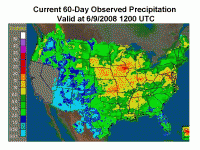By Joseph D’Aleo, CCM
This spring has been extremely wet and stormy in the central states thanks to a suppressed La Nina jet stream and strong contrast from cold in the north to warmth in the deep south. Storms riding on the supercharged jet stream and feeding on the heat and moisture have produced severe weather and excessive rainfall. Tornadoes are in the news almost daily, most recently in Omaha. Rivers are in flood in parts of the Midwest where rainfall (well over 20 inches in the last 3 months in places) has even exceeded spring levels in the record flood season of 1993. That doesn’t necessarily mean that this year in the end will have more flooding than in 1993 but it does often have a lot to say about what the summer will be like.

See large NOAA AHPS map here
There is a relationship between soil moisture and both precipitation and temperatures that becomes important in the spring and summer months. Forecasters pay close attention to this factor in their forecasts for summer. Soil moisture anomalies of significance tend to persist from spring to summer, except when major events like a landfalling hurricane act to intervene.
Very wet soils favor wetter summers and less extremes of heat (though not necessarily discomfort) in the summer, while very dry soils increase the chances of summer heat and drought. That is because wet soils and vegetation in the soil lead to more evaporation and transpiration of moisture, which is a cooling process that tends to hold daytime readings down. At night the elevated moisture content reduces the radiational cooling. With more moisture there may be more nighttime fog especially in valley areas and during the day more clouds, lower temperatures and better chances of showers from any lifting mechanisms. In this way wet areas favor more rainfall.
When the ground is very dry on the other hand, there is little evaporation and less plant transpiration especially if the water table is greatly lowered. The suns heat is more effective in warming ground temperatures. Higher temperatures and less moisture means lower humidity which desiccate the ground and vegetation further. There is less cloudiness and lifting mechanisms are much less effective in producing rainfall. In this way drought begets drought. Not surprisingly, there is a high persistence of soil moisture and Palmer Drought Indices from late spring into summer. See in this story why spring soil moisture is a good indicator of both summer rainfall and temperatures with example years.




